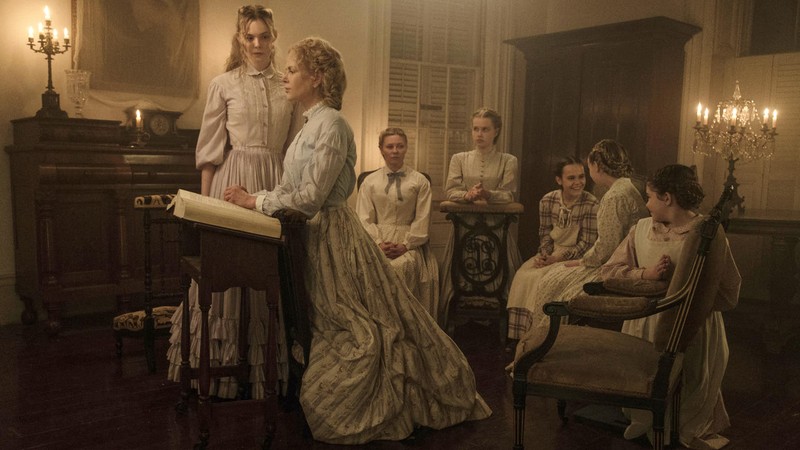
For anyone who's seen Don Siegel's sensational 1971 adaptation of The Beguiled, drawn from Thomas P. Cullinan’s gothic novel A Painted Devil, it's not hard to see why Sofia Coppola would be attracted to the material. From her debut feature, The Virgin Suicides, Coppola has had a lingering interest in the lives of women trapped by circumstance in one way or another, which the story—set in an all-girls boarding school in Virginia three years into the Civil War—ably extends. But while Coppola's vision is predictably sharp in the way that it tackles the story's sexual politics and laser-like focus on feminine desire, the film also feels flattened, its underlying lurid, psychosexual appeal absorbed into a kind of dreamy gossamer haze.
Immediately, the opening—the ornate pink curlicues of the title card; the figure of a small girl walking alone along the forest path framed by dense foliage, the morning fog drifting across; the muffled explosions of cannon-fire in the distance—acclimates us to the enthralling, threatening mood. But it's not long before one begins to feel that precision slipping from Coppola's grasp. Amy (Oona Laurence), a young girl out picking mushrooms in the nearby forest, happens upon the prone figure of Col. John McBurney (Colin Farrell), a Union soldier, and brings him back to the boarding school. It's a scene that should be filled with palpable danger and tension—and in Siegel’s original, where Clint Eastwood kisses a 12-year-old girl, even seduction—but that plays out as blandly cordial, almost perfunctory. That's true, too, of the scene that follows, in which the headmistress, Miss Martha Farnsworth (Nicole Kidman), the sole teacher, Miss Edwina Dabney (Kirsten Dunst), and the rest of the young girls take the injured McBurney in to be tended to, then kept locked in isolation.
In fact, that could be said of much of the film, which largely forgoes the story’s grimy underbelly for a relatively tame approach; it's a terse, stripped-down remake that retains the original's overall arc, but jettisons much of what made that version so compelling. (Among the differences from Siegel's adaptation, one of the most curious is that Hallie, the black servant in the original version, is omitted here.) In itself, that's more a neutral judgment, a manifestation of divergent visions. But Coppola, uncharacteristically, doesn't fare much better by the psychological detail. Once McBurney is taken into the house as a prisoner and unwelcome guest, the tenor of the space begins to change, as do the women. And it's in these cloistered rooms that the psychosexual tension—initially lent a fascinating pull by the film's distanced air—begins to flower. But the web of intrigue, deceit and jealousy—mainly between Miss Martha, Miss Edwina and Alicia (Elle Fanning), the eldest and most seductive of the students—is so loosely drawn that the decisive turn the story takes is drained of its supposed heft; it's somehow both flat and risible when it should be ridiculous, horrific and shocking all at once. That's due, in part, to the performances of the ensemble cast. The female actors fare well enough, particularly Dunst, who manages to convey an inward repression, a sense of woman with nowhere to turn, whose only desire is “to be taken far away.” But Farrell, playing the role that Clint Eastwood had originally, falters. He's charismatic and outwardly seductive, but almost too open in demeanor, conveying little sense of danger or inward desire lurking beneath—it’s a limited performance that really should be the impenetrable, fascinating center. But perhaps the main issue is the film's overall conception, which finds Coppola bending the potboiler drama to her more ethereal, composed style without really compensating for what gets, well, lost in translation. There's definite appeal in seeing the shocking, unsettling trajectory rendered with the textures of a fairy tale, primal desire sublimated into a gauzy repose. But while Coppola's sensibility is largely compelling—certainly a triumph of staging, costuming and period detail—in this context, the detachment also tempers the force of the story's most unhinged moments, so their impact is more compartmentalized.
Every frame of the film, shot by Philippe Le Sourd (who previously shot Wong Kar-wai's The Grandmaster) feels poised and meaningful, alternating between warm, candlelit interiors, dusky exteriors, and the threatening pallor beneath it all. Its rhythms, however, don't involve in the way one would expect given the surprisingly short runtime—just 94 minutes compared to the 105 of the original. Atypically, it's a streamlined film that may have done better with less “efficient” editing. (A late scene in which Miss Martha instructs Amy to tie a blue ribbon on the gates of the school-ground to signal “their” soldiers, which then cuts immediately to McBurney catching Amy doing so, is a particularly egregious example.) The approach does lend some brisk fascination to the finale, which pulls a shot straight out of the 1971 film (the camera tracking a dish passed along the dinner table), only to make a tension-diffusing, but purposeful departure. But the conscious rewriting of the original, although it enriches the film's ample subtext, also diminishes its immediate ground-level interest; symbolic richness is foregrounded at the expense of all else.
“The enemy is not what we had believed,” says Miss Farnsworth, which is as clear a (feminist) statement as they come, as is the final image, in which the camera pulls back from the women gathered behind iron-wrought gates of the school. The meaning is clear; but because The Beguiled is also so frustratingly limited (though accomplished in many respects), its implications resonate unfavorably in more ways than one.
